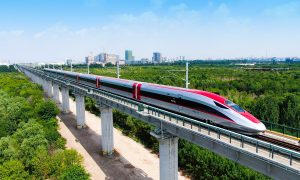PRASA is, in this story, the African story of the attempt to modernize and is worth reflecting upon. The original title, “After its dramatic derailing, is it even possible for Prasa to get back on track?” is amended to reflect that continental situatedness – Intervention
By Tim Cohen
Not long after the Second World War, the Japanese government took a huge bet on rail. It was controversial at the time because the world was moving toward road and air transport at a rapid pace. The rail network in Japan, like in South Africa, was generally narrow gauge, so building a new high-speed network would require a start-from-scratch approach.
The bet was based on physics. Rail transport, when implemented correctly, is more efficient in respect of both energy and time than road or air travel. But the capital cost of the construction exercise is, of course, far higher than road transport, particularly since the major capital item in the latter is borne on the balance sheet of the traveller.

The Japanese way of the train
Nevertheless, in the economic boom that followed Japan’s reconstruction, the head of the Japanese railways, Shinji Sogō, was convinced that a high-speed rail system would work and managed to convince politicians that it was worth a try. In 1959, construction began between Tokyo and Osaka, and the Shinkansen was born. The estimated cost was 200-billion yen (roughly $7-billion in today’s money), but when the line was completed four years later, the true cost ended up being double that. Sogo resigned.
But the line was a fabulous success. In 2017, it carried 159-million passengers. The distance between Tokyo and Osaka is about 500km, and the train takes about three hours, and a train leaves every half an hour. The train has carried in total about six billion passengers over the past five decades. The network has expanded dramatically, and the trains have got faster. The success of Shinkansen inspired high speed trains all over the world. And obviously, the trains leave on time. The rail service once took out national advertisements to apologise a few years ago when one of the trains left twenty seconds early.
If it is not too depressing, let us now change our focus to South Africa’s Passenger Rail Agency of South Africa (Prasa). I mean, it’s an unfair comparison. It’s slightly like comparing a Fiat Uno with a Ferrari, and that comparison does a disservice to the Fiat Uno.

And then the Chinese
And yet, is it so unfair? South Africa started building railways in 1859, and never stopped. SA has a rail network of 36,000 kilometres. That’s actually larger than the existing rail network in Japan. The big failure in SA has been – you guessed it – management. We kinda know the story. In 2012, Prasa paid a company called Swifambo Rail Leasing R3.5-billion to deliver locomotives, which they did, but sadly they were too tall and didn’t fit under SA bridges. Years later Swifambo’s director, Auswell Mashaba, admitted to the Zondo Commission that he paid the ANC R80-million.
And here, ladies and gentlemen, is the level of gob-smacking incompetence; the ANC never got the money because the person to whom he gave the money decided to keep it. What can you say? It’s sad when there is no honour left among thieves.The degree of involvement in the corrupt deal was enormous: 44 people have been implicated, but only 11 have resigned or been fired.
Clearly, the organisation was imploding from the inside for more than a decade. But yet, from the outside, it seemed to be holding up. James Stent from news service Groundup has done an excellent piece, showing 12 graphs which track Prasa’s decline.
From 2008 to 2014, Prasa’s fare revenue was still increasing every year. And then it dipped slightly downwards, and has now completely crashed, helped along by Covid. In 2008, PRASA collected R1.2-billion in fares, last year it collected R178-million.

And here comes PRASA
How did this happen? An old mate of mine, Chris Hock, told me a story just this week about a business-school exercise he attended with a group of around 20 execs. They were sat in a circle in the bushveld somewhere, where everyone was given a drum. A long-haired dude led the group in a whole bunch of drumming patterns until everyone was in the mood and feeling creatively musical. And then the dude said: watch what happens when I remove the base beat – and he stopped drumming.
Three profound lessons emerged, Chris says. At first there was no discernible change in the happy, jazzy beat. Second, the music goes on as normal for much longer than you’d think possible. And third, when it finally did break down, it broke down very quickly. This is a version of Ernest Hemingway’s famous characterisation of going bankrupt. “How did you go bankrupt?” one of his characters is asked. ”Two ways: Gradually, then suddenly.”
What intrigues me is whether this works in reverse. The new Prasa board are trying heroically to put the jigsaw back together, and passenger trains are beginning to appear again after the Covid shutdown. Does an organisation slowly improve, and you don’t really notice it, and then it suddenly it bounces back?
I’m sceptical. The Prasa board includes a whole bunch of new faces, but none outwardly has any obvious knowledge or love for train transport, although the new acting CEO Hishaam Emeran, has been with the organisation for years and was in charge of technical operations. Meanwhile, the taxi industry is eating Prasa’s lunch, just as the transport industry is white-anting Transnet’s income. And just for the record, not a single train operates on 35% of SA’s tracks.
The pound is being pounded, and the vix needs some vapour rub.
Good investing,




























